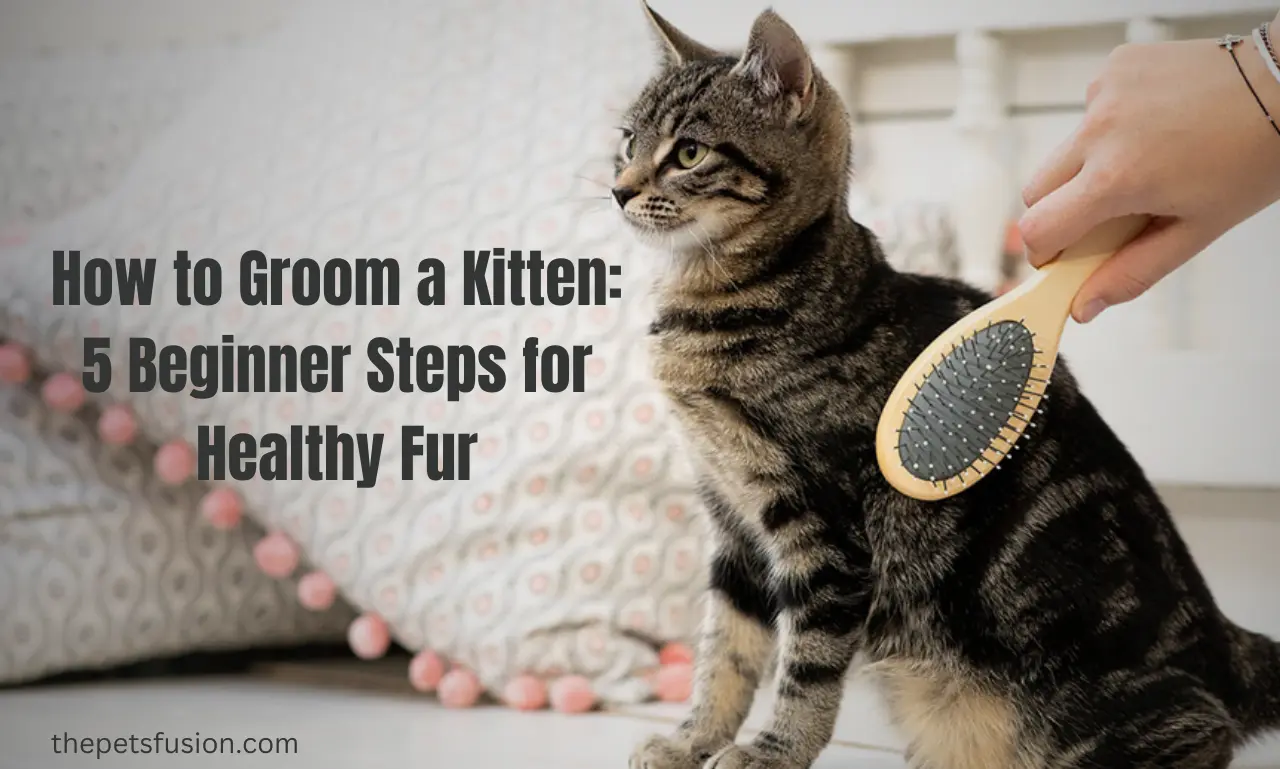Bringing home a kitten is like adding a whirlwind of energy and cuteness to your life. These tiny bundles of fur pounce into our hearts—but keeping that soft coat shiny, clean, and healthy takes more than just cuddles. Whether you’re a first-time cat owner or a skilled pet parent, understanding how to groom a kitten is essential for your kitten’s health, happiness, and your bond together. In this ultimate guide, we’ll walk you through the top 5 beginner steps to grooming your kitten, why grooming cats is more than just a beauty routine, and how to help your kitten eventually groom itself properly. From brushing and bathing to trimming nails and cleaning ears, we’ll cover it all—making sure you and your kitten both enjoy the process.
Why Grooming Your Kitten Matters
Before we get into the “how,” it’s worth knowing the “why.” Grooming isn’t just about making your kitten look cute for Instagram. It’s a vital part of feline wellness.
Benefits of Grooming Cats and Kittens
- Prevents hairballs: Regular brushing removes loose fur that would otherwise be swallowed.
- Maintains skin health: Grooming distributes natural oils and prevents matting.
- Reduces shedding: This is especially helpful for long-haired breeds.
- Improves circulation: Gentle brushing stimulates blood flow.
- Strengthens your bond: Grooming builds trust between you and your kitten.
- Early detection: You’ll spot signs of fleas, wounds, or skin conditions early.
Now, let’s break down how to groom a kitten into five easy-to-follow, beginner-friendly steps.
Step 1: Brushing – The Foundation of Healthy Fur
Brushing is the cornerstone of kitten grooming. Even short-haired cats benefit from regular brushing to reduce shedding and maintain a smooth coat.
How Often Should You Brush?
- Short-haired kittens: 2–3 times per week
- Long-haired kittens (like Persians or Maine Coons): Daily brushing is best
Tools You’ll Need
- Soft-bristle brush or rubber grooming mitt
- Fine-tooth flea comb (optional for spotting parasites)
- Detangling spray for long-haired breeds
Tips for Brushing a Kitten
- Start when your kitten is sleepy or after playtime.
- Begin with gentle strokes along the back and sides.
- Be extra gentle around the belly, legs, and tail.
- Show treats and credit to make it a positive experience.
Pro Tip: Incorporate brushing into your kitten’s daily routine to help them associate it with relaxation and comfort.
Step 2: Bathing – Yes, Sometimes It’s Necessary
Unlike dogs, grooming cats typically do not involve frequent bathing. However, kittens can be clumsy and messy explorers. If your kitten gets into something sticky or smelly, a gentle bath may be needed.
When Should You Bathe a Kitten?
- When they’re visibly dirty or have something toxic on their fur
- If they have fleas (recommended under vet guidance)
- For allergy control (some vets may recommend regular bathing)
Kitten Bath Checklist
- Warm (not hot) water
- Kitten-safe shampoo (never human or dog shampoo)
- Non-slip mat or towel for the sink
- Soft washcloth
- Towels for drying
- Optional: hairdryer on low setting for long-haired breeds
How to Bathe a Kitten (Safely!)
- Refill the sink with 2–3 inches of warm water.
- Gently lower your kitten into the water while speaking soothingly to it.
- Wet the fur using your hand or a cup (avoid face).
- Lather gently with shampoo, then rinse thoroughly.
- Pat them dry with a towel and keep them warm until they are scorched.
Note: Avoid over-bathing. It can rob natural oils and cause dry skin.
Step 3: Nail Trimming – Start Young to Avoid Scratches Later
Trimming your kitten’s nails might seem intimidating, but it’s a skill worth mastering early. Long nails can cause pain, get caught in furniture, or even grow into their paw pads.
How Often to Trim
Every 2–3 weeks, depending on activity level.
Tools You Need
- Cat nail clippers or baby nail scissors
- Styptic powder (to stop seeping if you accidentally cut too short)
Nail Trimming Tips
- Wait until your kitten is calm or sleepy.
- Hold the paw gently and press to extend the nail.
- Cut only the sharp tip, avoiding the pink “quick.”
- Reward with treats after each paw.
Did You Know? Kittens learn to tolerate paw handling more easily when exposed to it at an early age, making nail trims easier as adults.
Step 4: Ear and Eye Cleaning – Little Details, Big Impact
Cats are generally good at keeping themselves clean, but kittens may still need help with their ears and eyes, especially during their early development stages.
How to Clean Your Kitten’s Ears
- Use a vet-approved ear-cleaning solution
- Soak a cotton ball (never a Q-tip) and gently wipe the outer ear
- Look for signs of infection: redness, swelling, or foul odor
Cleaning Around the Eyes
- Utilize a soft, damp cloth to wipe away discharge
- Be gentle, and avoid applying pressure
Reminder: Be aware of symptoms of infection. If your kitten’s eye discharge is yellow or green, contact your vet.
Step 5: Teaching Your Kitten to Groom Itself
This step is often overlooked but incredibly important. While grooming cats is a natural behavior, some kittens—especially those who are orphaned or weaned too early—may not know how to do it properly.
How to Encourage Self-Grooming
- Groom them regularly—this teaches by example
- Use a grooming glove that mimics a cat’s tongue
- Keep their environment clean and low-stress
- Encourage play with other kittens (they groom each other!)
- Keep fur free of mats—matted fur can discourage grooming
Fun Fact: Grooming is a self-soothing behavior. Stressed kittens often groom less; therefore, managing their stress is crucial.
Additional Kitten Grooming Tips by Breed
Short-Haired Breeds (e.g., American Shorthair)
- Brush 2–3 times a week
- Occasional baths, if necessary
- Watch for dandruff or dry patches
Long-Haired Breeds (e.g., Ragdolls, Persians)
- Daily brushing to prevent mats
- Trim belly and armpit fur to reduce knots
- More frequent eye cleaning due to tear staining
Hairless Breeds (e.g., Sphynx)
- Weekly sponge baths (they still produce oil)
- Clean ears and folds carefully
- Use baby wipes for quick clean-ups
How to Handle Grooming Challenges
Fearful or Fussy Kittens
- Use positive reinforcement—praise and treats
- Go slow; break grooming into short sessions
- Wrap in a towel (“kitty burrito”) for nail trims if needed
Aggressive Behavior During Grooming
- Never punish—this increases fear
- Stop the session if your kitten gets too stressed
- Consider using a calming pheromone diffuser
Always stop and consult your veterinarian if your kitten appears to be in pain or is unusually distressed.
Do Kittens Groom Themselves?
Yes—but not always effective at first. Grooming is a learned behavior. Mother cats teach their kittens, but if your kitten was orphaned or separated too early, they may need extra help.
How to Get a Kitten to Groom Itself
- Regular brushing teaches the behavior
- Use mutual grooming toys or grooming gloves
- Socialize with other cats if possible
- Ensure a healthy diet—poor nutrition can reduce grooming
Related: 300+ Cute Cat Names for Your Adorable Kitty: Find the Perfect Name!
FAQs: Grooming Kittens for First-Time Owners
Q1: At what age should I start grooming my kitten?
As early as 3 to 4 weeks old. Starting young builds lifelong habits.
Q2: Do kittens require regular baths?
Not usually. Only bathe if they are dirty, have fleas, or need a medicated wash.
Q3: My kitten hates brushing—what do I do?
Start with short, gentle sessions, use soft brushes, and pair with treats or play.
Q4: Is it safe to use human shampoo on kittens?
No! Always use vet-approved kitten or cat shampoo.
Q5: Can grooming prevent hairballs?
Yes! Regular brushing removes loose fur before your kitten can swallow it.
Conclusion
Learning how to groom a kitten may feel overwhelming at first, but these five beginner-friendly steps will soon become second nature. Beyond just keeping your kitten cute and clean, grooming strengthens your relationship and supports their physical and emotional health. With the right tools, a gentle approach, and some patience, your kitten will not only tolerate grooming—but might even start to love it. And as they grow, you’ll notice them picking up the habit of self-grooming, keeping their fur healthy and their personality sparkling. So grab that soft brush, turn on some calming music, and enjoy this bonding time with your little furball. They’ll thank you with headbutts, purrs, and a lifetime of loyalty.






